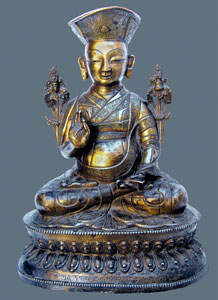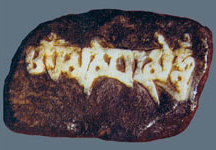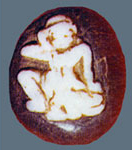


As early as during the reign of the 12th King of Ladakh Lhachen Ngodrub (reigned 1290-1320) one of the main pupils of Kyobpa Jigten Sumgon, Chenga Sherab Jungne (spyan snga shes rab ‘byung gnas, 1187-1241) visited Ladakh while he was staying in the Kailash region in western Tibet. He entered Ladakh (then called Mangyul, mang yul) through the region of lake Pangong. In its vicinity he spent some time meditating in a cave at Pangmig Serbumchen (pang mig gser bum can). Chenga Sherab Jungne used to walk down to the lake from his retreat cave along a path lined by flowers with golden blossoms called Serbum (gser bum). Hence also the monastery later built at this place was called Serbumchen (gser bum can).
At the shrine of Serbumchen a statue of Jigten Sumgon was erected during the lifetime of Sherab Jungne. Nearby the White Monastery (gon dkar po) was founded with a retreat center for practitioners. Serbumchen and Gonkarpo were the first establishments of the Drikung Kagyu lineage in Ladakh.
The antiquity of the presence of the Drikung Kagyu order in Ladakh is also evident from a lineage inscription preserved on the third floor of the Three-Storeyed Temple (gsum brtsegs) in the famous, very ancient and astonishingly beautiful and well-preserved temple complex of Alchi. In this inscription on the entrance wall, Kyobpa Jigten Sumgon is mentioned as the last person in the lineage, making the temple relatively well dateable to the early 13th century.

However for three centuries there was no expansion of the order in the region. This situation changed remarkably with the arrival of Denma Kunga Drakpa (ldan ma kun dga’ grags pa) as the new Dorzin (meditation master) at Gyangdrag Monastery at Mount Kailash in the early 16th century. His fame spread to the neighboring country and he accepted an invitation from the king of Ladakh, Tashi Namgyal (bkra shis rnam rgyal, ca. 1555-1575). According to a later legendary tradition, Denma Kunga Drakpa is linked to the Ladakhi King Jamyang Namgyal (‘jam dbyang rnam rgyal, ca. 1590-1616).

Purportedly no physician could heal the king from his leprosy and eventually an oracle pronounced that only Kunga Drakpa at mount Kailash could cure him. Upon receiving the invitation Kunga Drakpa went to the shore of lake Manarasowar (mtsho ma pham) to meditate and pray for guidance, when he lifted two stones out of the water: a black stone inscribed with the mani mantra and a very small pebble with a self-arisen image of Milarepa. He took these as auspicious signs, went to Ladakh and cured the king.
However this story cannot be sustained by chronology. In was already some decades earlier that Kunga Drakpa had followed the invitation from the Ladakhi king Tashi Namgyal when he journeyed to Mangyul. Kunga Drakpa became the root master of the king and was rewarded for his spiritual guidance with land and monasteries. It was due to his impressive personality and his efforts that the main monasteries of the Drikungpa were established in Ladakh: Phyang, Lamayuru, and Sharchukhul.
During the 18th century the 6th reincarnation of Togden Rinpoche, Tenzin Chodrak, had renewed the influence of the Drikungpa in Ladakh. He was the first tulku of his reincarnation lineage to leave central Tibet and settle in Phyang Monastery for a long time, where he became the teacher of two kings of Ladakh. The 8th Togden Ngawang Lodro Gyaltsen, who was the son of Jigme Kunga Namgyal, a prince of Ladakh, received his monastic training in Yangrigar Monastery. After his return he renovated the monasteries of Phyang and Lamayuru. The present 9th Togden Rinpoche Konchog Tenzin Thubten Tenpe Gyaltsen, born in 1938 in Dorkhul, a small village in eastern Ladakh, is one of the most learned and influential men in the spiritual life of Ladakh. He is also the 33rd Drikung Choje (Dharma Master) of Ladakh.

